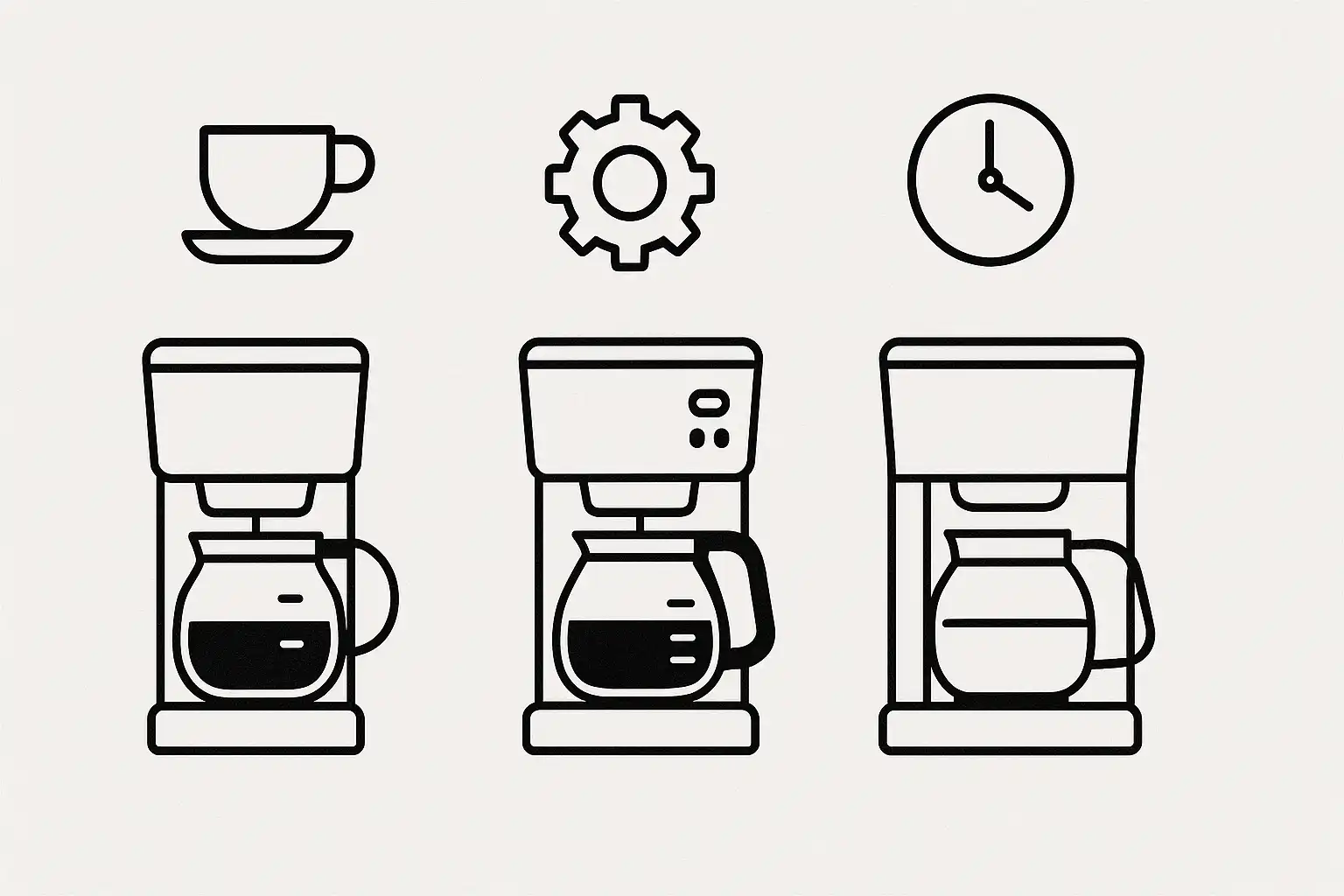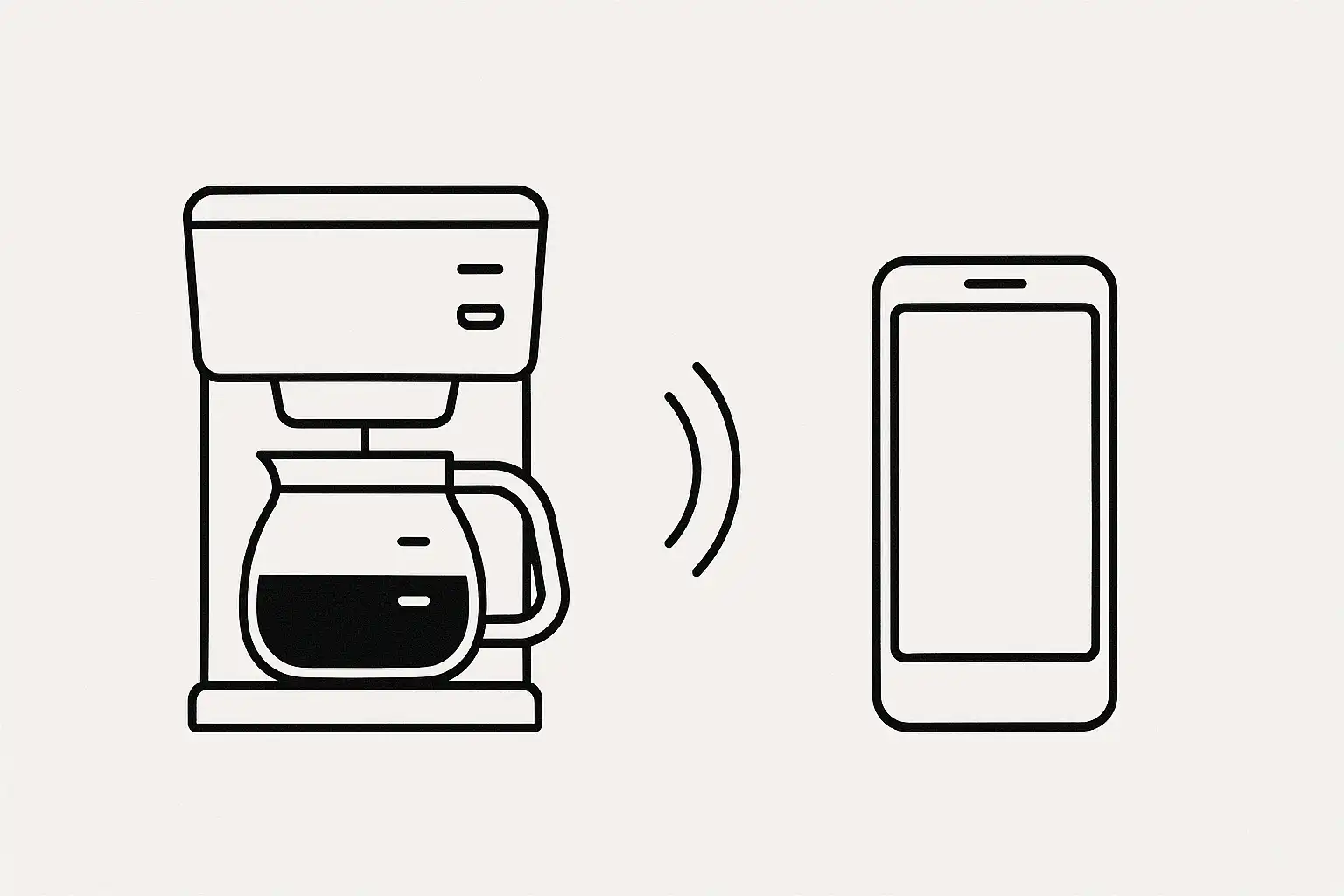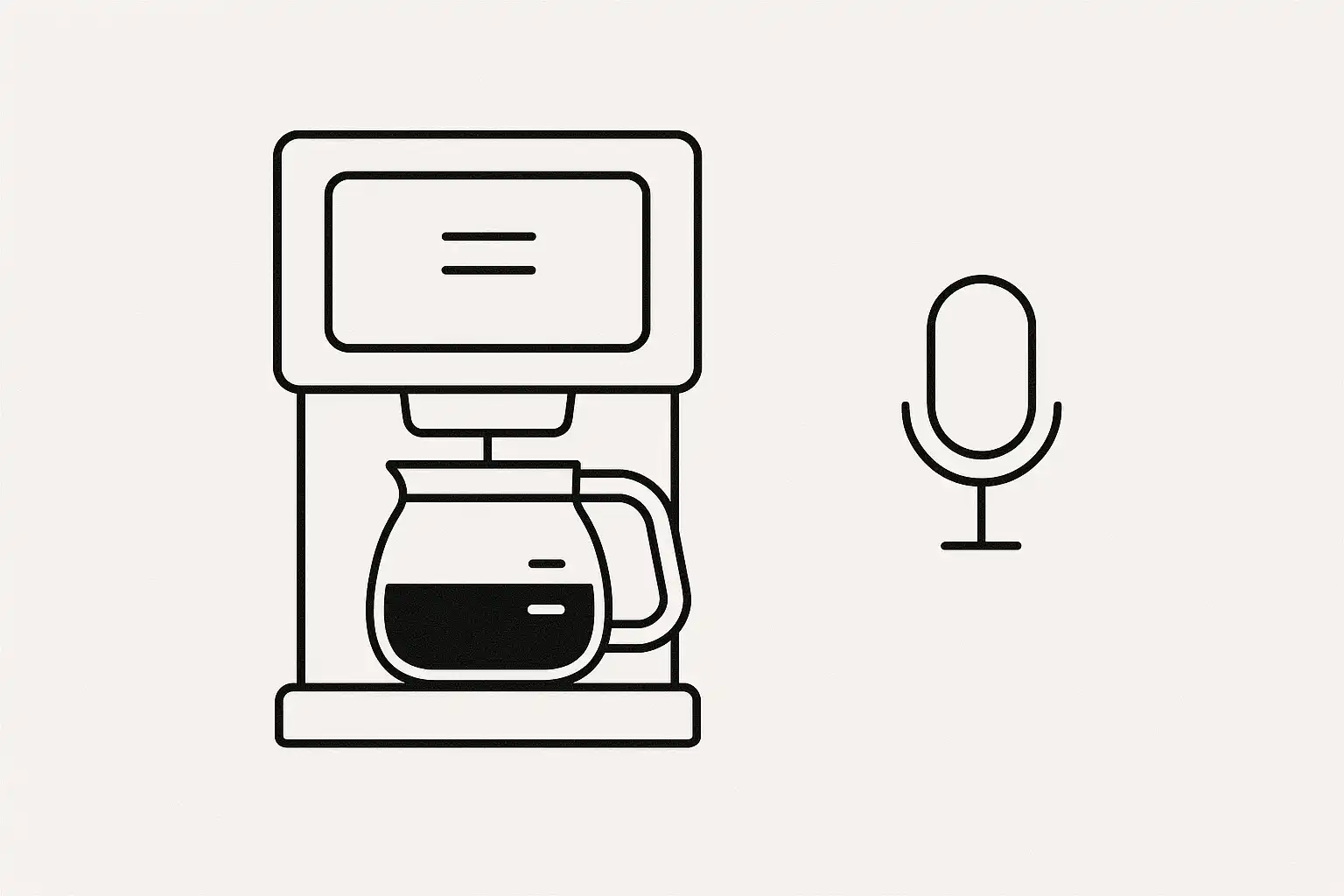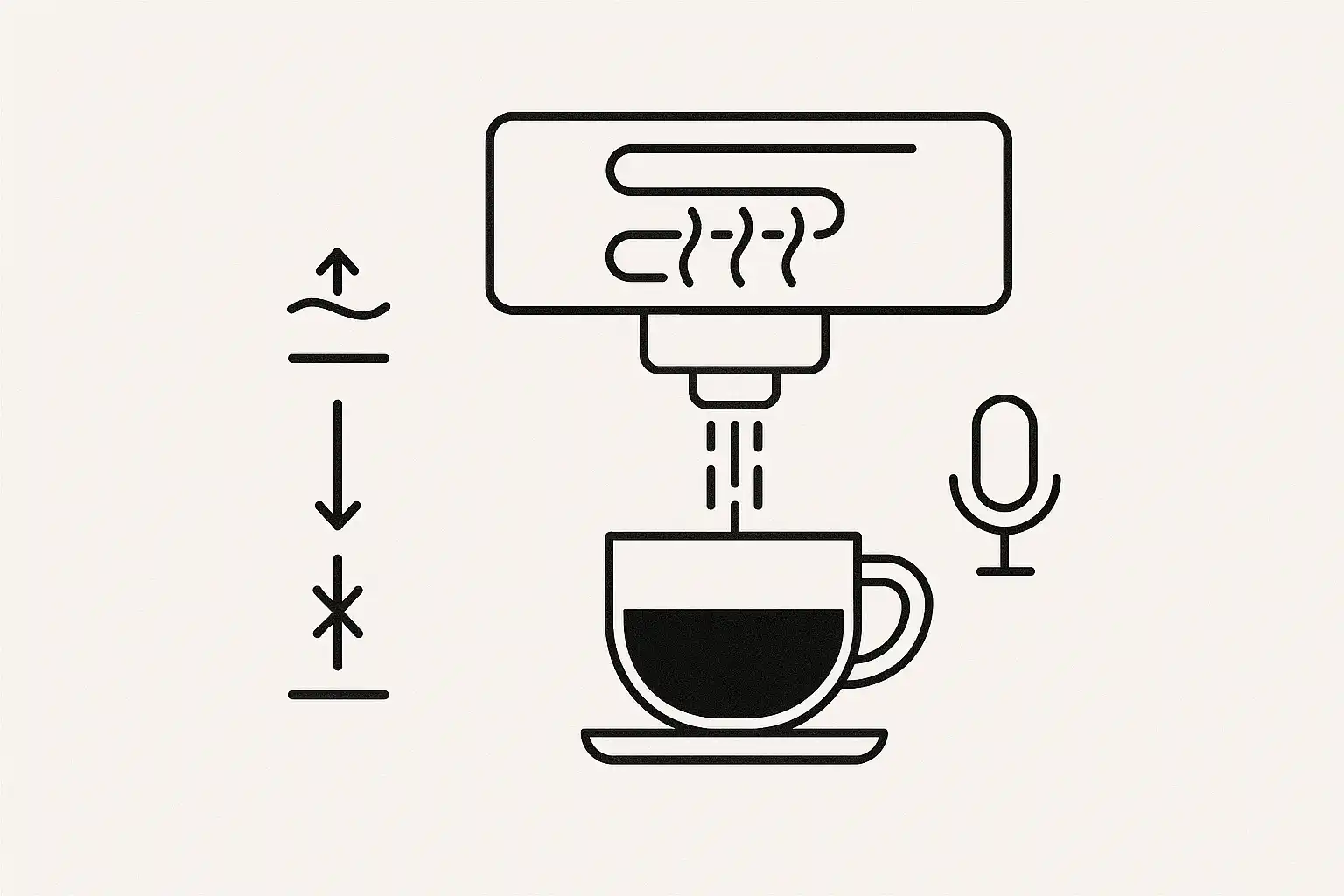When choosing a coffee maker, the real concern isn’t the number of add-ons. What matters is how each function affects flavor, usability, and daily brewing habits. Machines have moved far beyond simple drip systems.
Now they come with connected controls, fine-tuned brewing mechanics, and advanced milk options. In this guide, we break down the features that make a difference and how they influence everyday use.
Table of Contents
Important Factors When Choosing a Coffee Maker

The following sections highlight the ones that actually change the way you brew and drink coffee. By looking at controls, brewing mechanics, milk preparation, and everyday usability, the differences between machines become clearer.
Smart & Connected Controls
Connectivity now plays a direct role in how coffee makers fit into daily use. Wi-Fi or Bluetooth links allow brewing to be managed remotely, recipes to be stored, and maintenance reminders to arrive before issues build up. This reduces interruptions and helps keep brewing consistent over time.

App Integration
A useful companion app should make brewing faster and simpler. The most practical features to look for include:
- Quick setup through QR code or NFC pairing.
- Scheduling flexibility with options for weekdays and weekends.
- User profiles so each person can save their own brew preferences.
- Smart home compatibility with Google Home, Apple HomeKit, or Alexa.
- Maintenance tracking, such as descaling reminders or filter-change alerts.
It’s also important that the app receives regular updates. Without them, compatibility problems and connectivity issues can appear over time.
Remote Updates
Firmware updates extend the usefulness of a machine. Adjustments to brewing temperature, pump pressure, or internal software can be delivered wirelessly. This means the brewer doesn’t stay stuck with its launch version. Still, it’s smart to check how long the manufacturer supports updates—some do so for years, others stop quickly.
Notifications
Push alerts add convenience by sending reminders for low water levels, a full grounds bin, or upcoming cleaning cycles. Some machines also notify when brewing is finished, which is helpful if the coffee maker isn’t nearby. These alerts take away the guesswork and keep daily brewing on track.
Intuitive Interface & Voice Assistants
How a coffee maker interacts with the user has a direct impact on daily brewing. Clear controls reduce mistakes, speed up the process, and open the door to more advanced features. When combined with voice assistance, brewing can be done hands-free, adding flexibility to the kitchen routine.

Touchscreen Displays
Touchscreens have taken the place of complex button layouts on many machines. They simplify drink selection, adjust strength or size with a tap, and display progress during brewing. Icons and step-by-step prompts are helpful for maintenance tasks, such as rinsing or descaling.
A responsive screen makes all the difference here—slow or inaccurate touch inputs can quickly turn an advantage into a drawback. For day-to-day use, screens with adjustable brightness and anti-glare finishes are best, since kitchen lighting can shift dramatically throughout the day.
Voice Commands
Voice assistants such as Alexa, Google Assistant, and Siri now connect with a growing number of coffee makers. The most useful commands typically include:
- Starting or stopping a brew.
- Checking the machine’s water level.
- Adjusting coffee strength or temperature.
- Asking if maintenance is due, such as filter replacement.
- Triggering saved drink recipes.
The depth of integration matters. Some brewers only handle basic tasks, while others allow full recipe customization through voice alone. Feedback is also essential—hearing or seeing confirmation prevents accidental mis-brews. Machines that process at least some commands locally, rather than relying entirely on the cloud, add another layer of security.
One-Touch Programs
Preset programs allow favorite drinks to be made with a single press. Espresso, cappuccino, latte, and even cold brew can often be selected this way.
Stronger machines don’t lock users into fixed recipes—they let adjustments be made after the program finishes, like changing milk temperature or increasing espresso strength. This feature is particularly useful in shared households where each person has a preferred drink style. In some cases, custom recipes can even be saved to a dedicated button, combining speed with flexibility.
Precision Brewing Mechanics
Brewing precision directly affects taste, body, and repeatability. Three elements make the most difference: temperature stability, pre-infusion, and pressure control. When these are well-engineered, the cup is consistently better.

Temperature Control (PID)
PID controllers regulate heat with fine accuracy. Tests on dual-boiler PID machines show they can keep water around 94 °C ±0.7 °C across multiple consecutive shots. In contrast, heat exchanger machines often swing by ±2.3 °C, and single boiler models by ±5 °C. That difference changes the extraction balance: sour notes appear at lower temperatures, while bitterness creeps in when the heat runs too high.
Without PID, cheaper machines rely on thermostats that flip heating on and off. This causes big swings and slower recovery after a shot. A PID setup recovers quickly, meaning less waiting between drinks and more consistent extractions throughout the day.
Pre-Infusion
Pre-infusion wets the puck gently before full pressure ramps up. Done correctly, it reduces channeling and encourages even extraction.
- Typical settings: 2–3 bars for a few seconds, then a rise to full brew pressure.
- Machines with pressure profiling expand on this, letting users control the rate of increase. Slow, staged ramps can produce smoother flavors and draw out delicate notes.
For darker roasts, short pre-infusion limits bitterness. For lighter roasts, longer wetting helps dissolve complex flavors more evenly.
Pressure Control
Espresso is traditionally extracted at 9 bars—a standard adopted by commercial and most home machines. Pumps often have higher maximum ratings (15–20 bars), but internal valves usually regulate pressure down to 9. The extra headroom helps overcome resistance from grind or tamp inconsistencies, but the target during brewing rarely changes.
Consistency is the key. If pressure fluctuates mid-shot, flavor suffers: crema thins, acidity spikes, or harsh bitterness develops. Well-built pumps and stable valves hold pressure steady across the entire extraction, giving balanced results every time.
Versatility of Brewing Styles
Machines that handle more than one brew type have to manage water temperature, pressure, and timing across very different ranges. Espresso, drip, and cold brew all demand distinct mechanics, and only well-designed systems handle the transition smoothly.
Espresso vs Drip
- Pressure and time: Espresso extraction happens under about 9 bars of pressure in 20–30 seconds, using a fine grind. Drip coffee uses gravity, medium grind size, and hot water at 90–96 °C (195–205 °F), with brew times around 4–7 minutes.
- Strength and volume: A single espresso shot (25–35 ml from 7–9 g of coffee) is concentrated, while a full drip cup (about 237 ml) delivers more caffeine overall because of the larger serving size.
- Flavor profile: Espresso is rich, with a heavier body and crema. Drip coffee highlights clarity, acidity, and subtle flavors like fruit or floral notes, especially in lighter roasts.
Cold Brew Options
- Steep time: Most cold brew recipes call for 12–24 hours of steeping, though some extend to 48 hours for a strong concentrate.
- Ratios: Typical concentrate recipes use 1:4 to 1:6 coffee-to-water by weight. The final drink is usually diluted before serving.
- Flavor and acidity: Cold brew is smoother and lower in acidity because extraction occurs without heat, which leaves behind certain sharp compounds.
- Storage: Concentrate lasts 5–7 days refrigerated before flavor noticeably drops. Ready-to-drink cold brew is best within 1–2 days.
Machines with a cold brew function should allow coarse grounds, long steep settings, and a way to keep the batch chilled once it’s finished.
Multi-Mode Brewers
- Preset modes: Some machines come with espresso, drip, pour-over, or cold brew presets. The most useful ones let you adjust temperature, strength, and volume.
- Grind compatibility: A real multi-mode brewer should handle both fine espresso grinds and coarse settings for cold brew or French press styles.
- Capacity: Espresso requires small volumes, but drip and cold brew can require a liter or more. Machines that maintain extraction quality across such a wide range are rare.
- Compromise factor: All-in-one machines often perform better in one style than others. For instance, drip may be excellent, but espresso might fall short of café standards.
Milk Preparation Options
Milk handling can change an ordinary cup into something closer to café quality. Machines differ in how they create texture, and each system offers its own balance of control, speed, and convenience.
Built-In Frother
Automatic frothers draw milk directly into the machine, heat it, and inject air to produce foam. The process is quick and reliable, ideal for users who want cappuccinos or lattes without much effort.
On the downside, adjustments are usually limited. Foam density and temperature often stick to factory presets. While some models let you tweak settings, they rarely deliver the same precision as manual steaming.
Steam Wand
A steam wand shifts the responsibility to the user, but it also unlocks finer control. Depth of the wand, angle of the pitcher, and the amount of air introduced all influence texture. With practice, it’s possible to create smooth microfoam for latte art or denser foam for cappuccinos. Temperature management is also manual, and overheated milk can flatten flavors. Strong steam boilers give better results, holding steady pressure shot after shot. Machines with weaker steam systems struggle here—the result is often milk that turns thin or overly frothy.
Separate Milk Container
Some designs use a removable carafe that clips onto the machine. The system pulls milk through a tube, froths it, and dispenses it into the cup. After brewing, the container can go straight back into the refrigerator, which helps reduce waste and keeps milk fresh for the next use.
Cleaning is easier compared to internal systems since the parts detach and rinse quickly. Foam quality, though, varies. Well-built carafes create foam that holds its texture, while weaker models leave bubbles that collapse into a watery layer. For people who want convenience with minimal cleanup, this option often feels like a practical middle ground.
Ease of Cleaning & Maintenance Automation
Cleaning is often the hidden factor that decides how long a machine keeps brewing well. Oils, stray grounds, and mineral deposits build up quickly. Left unchecked, they dull the flavor and shorten the life of internal parts. Coffee makers designed with cleaning in mind reduce that risk and make upkeep less of a chore.
Self-Cleaning Cycles
Rinse cycles run automatically in many machines, usually right after a brew or during shutdown. They flush oils before they dry inside the system. Descaling programs are more involved: using tablets or solutions, they break down limescale in boilers and pipes. Depending on the model, this can take 15 to 40 minutes. Machines that remind users when descaling is due help keep mineral buildup under control, especially in hard water areas where scaling happens fast.
Removable Brew Group
In super-automatic machines, the brew group is where tamping and extraction take place. Some designs let you remove it and clean it directly, which has several advantages:
- Direct rinsing under tap water removes sticky residues quickly.
- Lower risk of mold growth since hidden damp spots get cleared.
- Easier inspection allows you to spot wear or cracks before they cause breakdowns.
- Better hygiene compared to relying only on automated cycles.
Fixed brew groups rely solely on internal cleaning programs. While convenient, they may not reach every surface. Removable ones require a bit more effort, but they give users confidence that the machine’s core brewing system is fully maintained.
Dishwasher-Safe Parts
Drip trays, carafes, milk containers, and water tanks often come apart for washing. Not all can handle a dishwasher, though. Heat-resistant plastics and stainless steel usually fare well; softer plastics can warp or cloud after repeated cycles. Dishwasher-safe parts make routine cleaning faster and more reliable, especially when it comes to stubborn milk residue.
Energy Efficiency & Eco Features
Features that cut down on wasted energy and reduce environmental impact are becoming standard, and they also make the machine safer and cheaper to operate over time.
Auto Shut-Off
Most modern machines include automatic shut-off timers. Heating elements are among the biggest power draws, and leaving them on too long risks both energy waste and damage.
Shut-off times vary—some machines power down after 30 minutes, while others allow users to program anything from a few minutes to a couple of hours. This function is especially important for drip machines with hot plates, since those plates continue to burn electricity and can scorch coffee if left on.
Energy-Saving Modes
Energy-saving modes usually reduce boiler activity or switch systems into standby when not in use. On espresso machines, this might mean letting the boiler cool slightly while keeping sensors active, cutting consumption without requiring a full reheat from cold.
Some drip brewers also use insulated heating elements that require less energy to maintain water at brewing temperature. For heavy users who brew multiple times a day, standby modes save electricity without adding long wait times.
Sustainable Materials
The choice of materials affects both durability and long-term environmental impact. More manufacturers now consider alternatives to virgin plastics and short-lived components. Common directions include:
- Recycled aluminum for housings or trim, reducing the need for freshly mined metal.
- Bioplastics made from renewable sources are often used in water tanks or drip trays.
- Glass and stainless steel in carafes or boilers, both of which last longer and are easier to recycle.
- BPA-free plastics that meet food safety standards while avoiding harmful chemicals.
These changes don’t alter taste directly, but they extend machine life and reduce waste. A coffee maker built with durable parts also needs fewer replacements over the years, lowering both cost and environmental load.
Heat Retention & Carafe Design
Keeping coffee hot after brewing has a direct effect on both taste and efficiency. A carafe that maintains temperature without altering flavor prevents the dull, burnt edge that develops when heat is poorly managed.
Thermal Carafe
Double-wall stainless steel designs dominate this category. A quality thermal carafe holds coffee above 65 °C (150 °F) for four to six hours, long enough for most households.
Since there’s no hot plate involved, the flavor stays stable instead of shifting toward bitterness. Safety improves, too, with no heated element left running unattended. They do weigh more than glass, and preheating with hot water before brewing often gives the best results, but for slow sipping, they’re hard to beat.
Glass Carafe with Hot Plate
Glass carafes make it easy to monitor coffee levels and are light enough for effortless handling. Paired with a hot plate, they keep coffee warm for one to two hours. The drawback is flavor stability. Prolonged contact with constant heat darkens the brew and adds bitterness.
Some machines address this by lowering plate temperature after the first 30–40 minutes, slowing the decline in quality. Breakage risk is higher than with stainless steel, though replacement glass is widely available.
Insulation Levels
Thermal performance depends on more than just walls of steel. Several factors set high-performing designs apart:
- Heat retention time: Basic models lose drinkable warmth after two or three hours, while vacuum-insulated carafes stretch that to six or more.
- Lid construction: A well-sealed lid keeps heat in; a loose one undermines the insulation, no matter how thick the walls are.
- Material quality: Heavy-gauge stainless interiors hold heat better than thin or cheaper alloys.
- Glass systems: For glass carafes, insulation is really about the hot plate. Machines with adjustable plate temperatures can keep coffee warm without cooking it.
User-Friendly Features & Daily Convenience
Everyday usability often comes down to the smallest design choices. A machine that refills quickly or remembers schedules saves time and keeps the routine running smoothly.
Removable Water Tank
Detachable tanks simplify refilling, especially when the brewer is tucked under cabinets. Tanks with handles and clear markings cut down on spills. Larger capacities mean fewer trips to the sink, which matters in homes with multiple coffee drinkers.
Water Level Indicators
Transparent windows or digital readouts make it easy to check how much water remains. Clear indicators prevent dry runs that stress pumps and help avoid brewing weak coffee by accident. Dual measurements in ounces and cups make them useful for different habits.
Programmable Timer
Timers allow fresh coffee to be ready the moment it’s needed. Modern systems often support day-by-day scheduling, so weekday mornings and weekends can follow different routines. Backup memory keeps settings safe during short outages, which saves the hassle of resetting everything.
Conclusion
A strong coffee maker balances brewing precision with features that genuinely improve daily use. Smart controls, thoughtful carafe design, and practical upkeep tools all contribute to better flavor and fewer interruptions. Choosing carefully means the machine can deliver reliable cups for years without feeling outdated.
This content is generated by AI, reviewed by our editorial team, and features products that have been thoroughly evaluated and chosen.





